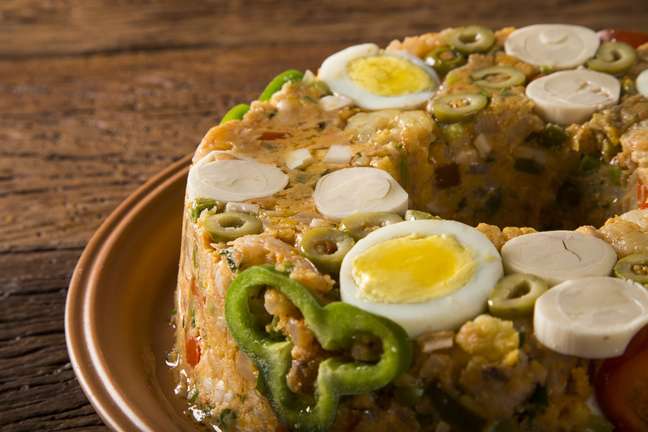A classic São Paulo delicacy is often “canceled” on social media, but still appears on restaurant menus
Turn and move, São Paulo couscous becomes a target of social networks. The reason? People, mainly from outside the state of Sao Paulo, don’t understand the success the dish has in Sao Paulo. The allegations range from “it’s a bunch of leftover ingredients” to an “unrefined version of Portuguese pizza”. But, despite this, the dish is still present in the menus and in people’s taste.

In restaurants like Bar da Dona Onça or the The curecouscous continues to appear on the menu in different versions – after all, even if it has a definite essence, the execution can vary greatly from one chef to another.
“It is a very rustic food. The fish couscous refers to our coast and the cassava culture also speaks of the indigenous nuances. That is, the couscous of São Paulo speaks of São Paulo and this welcome as a city of immigration and different cultures”, contextualizes the chef Janaína Rueda, the name of Dona Onça and a lover of couscous.
History of couscous from San Paolo
Any dish with Brazilian couscous, regardless of whether it is from São Paulo or from the north-east, has the same origin: an African dish, also called kuz-kuz or alcuzcus, and which today is popularly known in Brazil as Moroccan couscous. Originally from North Africa, this dish was brought to Portugal during the Arab invasion of the Iberian Peninsula and, according to Câmara Cascudo, arrived in the captaincy of São Vicente in the first century of colonization.
It gained even more strength during the 18th century, when slave women prepared the delicacy with catfish, abundant in the rivers of the Vale do Parnaíba region, or with sardines, consumed by wealthy families in the capital, demonstrating the versatility of the dish. .
“Soon we begin to prepare couscous with corn semolina, which the Indians already knew and used”, contextualizes Carlos Alberto Dória, sociologist and researcher of the roots of Brazilian gastronomy. “Upon arrival in Brazil and when the dish became popular in Sao Paulo, they started using the mixed version with meat and vegetables, instead of the one served on the side, like rice. Others who will enter the country’s hinterland in seeks other riches “.
Over time, Dória points out, even the couscous of São Paulo has undergone transformations. The more artisanal Biju flour began to lose ground in favor of the less traditional flocão. The main change, however, came in the preparation.
“An important feature of São Paulo couscous is that it is steamed. But it is not done anymore. In the 20th century, couscous made in a pan and then molded into the shape of a pie, as if it were a savory pudding, became popular. that you cut a slice and serve it on your plate “, explains Carlos Dória. “This couscous is very popular, very wide. It is eaten at home, in bars, in restaurants. This dating, this facilitation in the way of preparing, has thus conquered the public. By abandoning the steam, it has stabilized once and for all in the popular taste “.
popular couscous
Questioned, the chefs serving the dish on their menus don’t think twice and believe that couscous still has a long way to go. “Not only is there space in Sao Paulo’s gastronomy, but I end up bringing this and other Brazilian techniques to other states and countries,” says Janaína Rueda, when asked about the future of the dish. “I’m going to Croatia in May and I’m already wondering which flours are there to prepare maybe there, with my technique of couscous in a pot and something similar to cassava or corn flour, a cous cous and tell the story of this dish”.
If in doubt about how popular São Paulo couscous is, a good option is to ask Malu Zacarias, owner of Cuscuz da Malu. Calling himself “couscous for passion”, he sold 600 kilos of couscous last Christmas and 300 kilos last Easter. “He has been part of so many moments”, contextualizes Malu, who proposes couscous with prawns, sardines, the famous x-tudo, cod and, very successful, with crab meat.
Regarding the controversy over couscous, all respondents responded in unison on this one: nothing will detract from the sheen of the couscous. “This is neighborhood, it is regionalism. It does not matter for gastronomy. It is nonsense”, replies, without much patience to enter into the merits of this virtual cancellation of a historic dish, Carlos Alberto Dória.
Janaína Rueda also thinks it’s a good way to see the fun in this controversy. “Couscous from São Paulo is very important in Brazilian gastronomy, so much so that, if it weren’t for this, it would not be controversial. It is controversial because it has relevance! I see the dispute between northeastern couscous and that of São Paulo as a healthy game : the north-east says that the paulista has nothing to do with people from São Paulo who say ours is better. It’s a natural neighborhood, “he says. “This type of game ends up being interesting for gastronomy because it fosters a positive dialogue, each one following their own traditions”.
+The best content in your email for free. Choose your favorite Earth Newsletter. Click here!
Source: Terra
Benjamin Smith is a fashion journalist and author at Gossipify, known for his coverage of the latest fashion trends and industry insights. He writes about clothing, shoes, accessories, and runway shows, providing in-depth analysis and unique perspectives. He’s respected for his ability to spot emerging designers and trends, and for providing practical fashion advice to readers.








